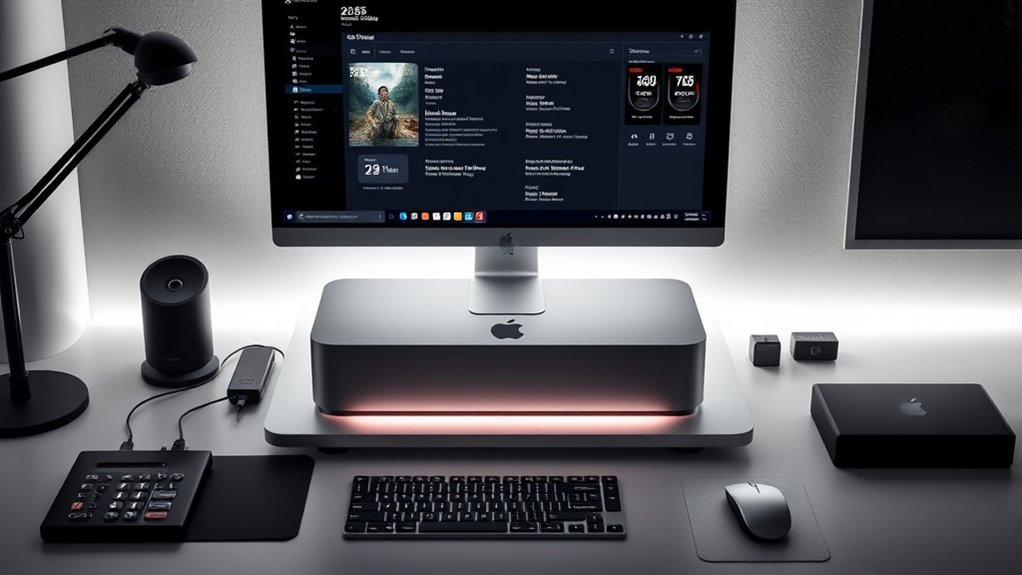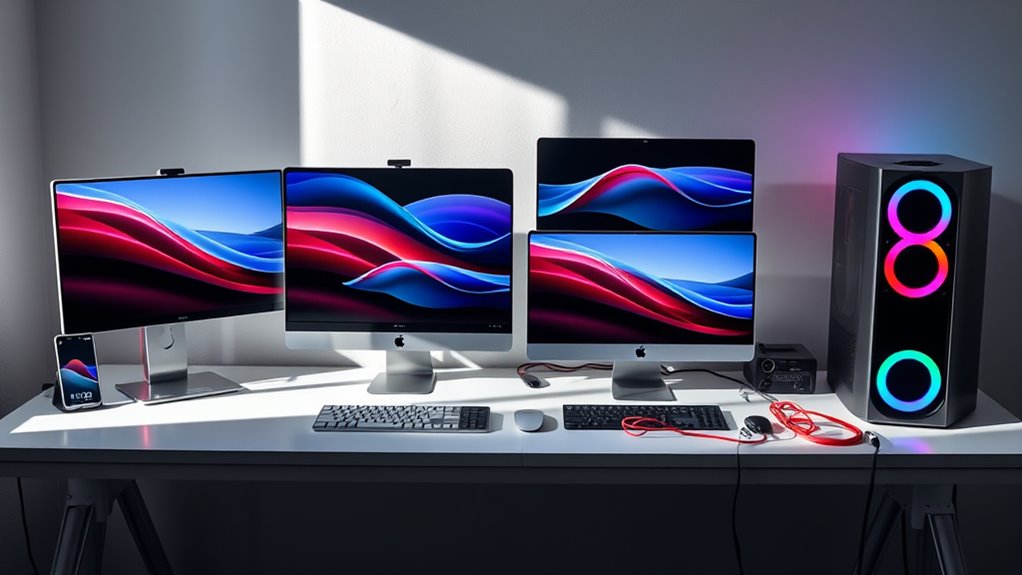In 2025, choosing the right Mac Studio depends on your workflow, storage needs, and budget. For demanding creative tasks like video editing, I recommend the M4 Pro with more RAM and a larger SSD. If you’re focused on general productivity, the base M4 model might suffice. For higher-end performance, consider upgraded configurations with better GPUs and bigger storage. Keep in mind your display setup and long-term needs—more details ahead can help you find the perfect fit.
Key Takeaways
- Determine your performance needs: choose M4 for general use, M4 Pro for demanding creative tasks like video editing or 3D rendering.
- Select storage capacity based on project size: 512GB–1TB for most professionals, 2TB+ for extensive media libraries and future growth.
- Verify display and port requirements: ensure support for multiple high-resolution monitors and necessary connectivity options like Thunderbolt 4 or HDMI.
- Consider software compatibility and space constraints: match macOS and creative tools to your workflow, and utilize the compact size for limited workspace setups.
- Balance budget with future-proofing: prioritize essential features like RAM and SSD capacity, while avoiding overspending on less critical specifications.
Apple 2024 Mac mini Desktop Computer with M4 Chip
If you’re looking for a compact desktop that packs a punch, the Apple 2024 Mac mini with the M4 chip is an excellent choice. Its small five-by-five-inch design easily fits next to monitors or in tight spaces. Powered by the M4 chip, it offers a 10-core CPU and GPU, 24GB of unified memory, and a 512GB SSD, delivering fast, responsive performance. It features a variety of ports, including Thunderbolt, HDMI, and Ethernet, for versatile connectivity. Built around Apple silicon, it seamlessly integrates with the Apple ecosystem, supporting macOS apps and features like iPhone mirroring and ecosystem synchronization, making it perfect for productivity and creativity.
Best For: professionals and creatives who need a compact, powerful desktop that seamlessly integrates with the Apple ecosystem for productivity and multimedia tasks.
Pros:
- Compact size easily fits in tight spaces or next to monitors
- Powerful M4 chip with 10-core CPU and GPU delivers fast, responsive performance
- Excellent ecosystem integration with features like iPhone mirroring and device synchronization
Cons:
- Limited storage options starting at 512GB SSD may not suit all users
- Price point can be high for budget-conscious buyers
- Limited upgradeability due to small form factor and integrated components
Apple Mac mini Desktop Computer with M4 Chip (256GB SSD, 16GB RAM)
The Apple Mac mini with M4 chip is an excellent choice for professionals and power users who need a compact yet highly capable desktop. Its small size, measuring just 5×5 inches, makes it perfect for tight spaces or cluttered desks. Powered by the M4 chip with a 10-core CPU and GPU, plus 16GB of unified memory, it delivers fast, smooth performance across demanding tasks. The 256GB SSD provides ample storage, and the versatile ports—including Thunderbolt, HDMI, USB-C, and Ethernet—ensure easy connectivity. Whether for work or creative projects, this mini packs impressive power and seamless integration into the Apple ecosystem.
Best For: professionals and power users seeking a compact, high-performance desktop with seamless Apple ecosystem integration.
Pros:
- Compact size fits easily into any workspace or tight space
- Powerful M4 chip with 10-core CPU and GPU ensures fast, smooth performance
- Versatile connectivity options including Thunderbolt, HDMI, and Ethernet
Cons:
- Limited internal storage with 256GB SSD may require external drives for large files
- May be overpowered for casual users with basic computing needs
- Small form factor might limit upgradeability or expandability
Apple 2024 Mac mini Desktop Computer with M4 Pro Chip
For professionals and space-conscious users seeking powerful performance in a compact package, the 2024 Mac mini with M4 Pro chip stands out. Its sleek 5-inch square design and lightweight build make it perfect for tight spaces or desktop setups. Despite its small size, it offers impressive performance—around 20% faster CPU, better GPU, and a 35% boost in AI tasks thanks to the 16-core Neural Engine. Connectivity is robust, with Thunderbolt 5, HDMI, Ethernet, and multiple USB-C ports. It supports up to three displays and handles demanding creative tasks smoothly. The device runs quietly and efficiently, making it an excellent choice for productivity and multimedia work.
Best For: space-conscious professionals and creative users who need powerful performance in a compact desktop setup.
Pros:
- Sleek, compact design ideal for tight spaces and desktop setups
- Powerful M4 Pro chip with significant performance and AI enhancements
- Support for up to three high-resolution displays, perfect for multitasking and creative workflows
Cons:
- Lack of USB-A ports, requiring adapters for some peripherals
- Less intuitive placement of the power button at the bottom
- Limited base memory options, which may restrict intensive tasks for some users
Apple Mac mini Desktop Computer with M4 Chip, 16GB Memory, 512GB SSD
Looking for a compact yet powerful desktop that handles demanding creative tasks with ease? The Mac mini with M4 chip, 16GB memory, and 512GB SSD delivers impressive performance in a tiny footprint. Its sleek aluminum design measures just 5 inches square and weighs only 1.5 pounds, making it perfect for tight spaces or on-the-go setups. Powered by the latest M4 chip, it offers a significant boost in CPU and GPU performance, supporting multiple high-resolution displays and demanding applications like video editing and 3D rendering. Despite its small size, it provides robust connectivity options—though you’ll need adapters for some USB-A peripherals.
Best For: creative professionals and power users seeking a compact, high-performance desktop capable of handling demanding tasks like video editing, 3D rendering, and multitasking with multiple high-resolution displays.
Pros:
- Compact and sleek aluminum design perfect for small spaces and portability
- Powerful M4 chip with a 10-core CPU and GPU for excellent performance in creative workflows
- Supports up to three external high-resolution displays for multitasking and professional use
Cons:
- No USB-A ports, requiring adapters for legacy peripherals
- Power button placement at the bottom may be less intuitive for some users
- Limited base memory (16GB) may impact extremely demanding tasks without upgrades
Factors to Consider When Choosing Mac Studio Configurations

When choosing a Mac Studio configuration, I consider my performance needs, budget, and storage requirements to make certain everything works smoothly together. I also look at display compatibility and connectivity options to guarantee everything works smoothly together. These factors help me make an informed decision that fits both my workflow and wallet.
Performance Needs
Choosing the right Mac Studio configuration hinges on understanding your performance needs. If you work with demanding software like video editing or 3D rendering, you’ll want a more powerful processor, such as the M4 Pro, which delivers about 20% better CPU performance. For smoother multitasking and faster processing, consider increasing RAM to 64GB or more. Larger SSD storage, like 2TB or higher, helps manage big files efficiently and minimizes data transfer delays. If your work involves high-resolution external displays, prioritize models supporting dual 6K or 8K monitors. Additionally, a stronger GPU, such as the 16-core option in the M4 Pro, notably speeds up rendering and graphics-intensive tasks. Matching your configuration to your workload ensures ideal performance and productivity.
Budget Constraints
Budget constraints play a significant role in determining the right Mac Studio setup. I recommend setting a clear budget range before exploring options to stay financially feasible. It’s important to take into account the cost differences between configurations with various memory, storage, and processor options to find a balance that suits your needs. Higher-end models with advanced chips and larger SSDs can quickly drive up the price, so weigh whether those features are essential for your work. Also, think about potential future costs, like upgrades or external peripherals if you choose a more budget-friendly model. Prioritize features that truly matter for your tasks, avoiding overspending on unnecessary specifications. Staying within your budget ensures you get the best value without compromising your core requirements.
Storage Requirements
Evaluating your storage requirements is essential to selecting the right Mac Studio configuration. Think about your current files and applications, and consider future needs as your projects grow. If you work with large media files or complex projects, opting for 1TB or more ensures you won’t run out of space quickly. External drives can also supplement internal storage, offering flexibility without increasing the initial cost. Keep in mind, faster SSDs improve load times and data transfer, boosting your workflow efficiency. However, higher storage capacities usually come with a higher price tag, so balance your needs with your budget. By carefully appraising your storage demands now, you’ll choose a Mac Studio that supports your work both today and down the road.
Display Compatibility
Ensuring your Mac Studio setup supports your display needs is essential for a seamless visual experience. First, verify that your chosen configuration can handle your intended number and resolution of external displays, like 6K or 8K monitors. Check that the available ports—Thunderbolt 4, HDMI, or USB-C—match your display’s input connections. It’s also important to confirm that the GPU can manage the graphics demands of high-resolution or multi-display setups, ensuring smooth performance. Consider supported display protocols, such as DisplayPort 1.4 or HDMI 2.1, to guarantee high-bandwidth video output. Finally, assess whether the hardware can support features like HDR, high refresh rates, or color accuracy, especially if you’re working in professional visual fields. Proper compatibility guarantees a flawless, high-quality visual experience.
Connectivity Options
Choosing the right connectivity options for your Mac Studio setup directly impacts how smoothly you can work with peripherals and external devices. I recommend making sure your configuration has enough Thunderbolt ports, as they support high-speed data transfer, external displays, and daisy-chaining. It’s also important to have a variety of options like HDMI, USB-C, and Ethernet to meet different peripheral and networking needs. Keep in mind that some newer models may lack USB-A ports, so adapters might be necessary for older peripherals. Additionally, check the number and types of display outputs if you plan to connect multiple high-resolution monitors. Finally, high-speed networking options like 10Gb Ethernet and Wi-Fi 6E ensure fast, reliable internet, keeping your workflow uninterrupted.
Software Compatibility
When selecting a Mac Studio configuration, it’s crucial to verify that it’s compatible with the macOS version your applications require. This helps prevent software issues and ensures smooth operation. Make sure all essential creative and productivity tools, like Adobe Creative Cloud or Microsoft 365, support the M4 or M4 Pro chip architecture for peak performance. Check if any specialized software has specific hardware or system needs to avoid compatibility problems. Additionally, confirm that your peripherals or plugins work with the Mac Studio’s ports and connectivity options. If you plan to use virtualization or emulation software, verify that your chosen configuration can support these solutions without performance bottlenecks. Proper compatibility checks save time and help you get the most out of your setup.
Space Limitations
The compact size of the Mac Studio makes it a popular choice for users with limited desk space, measuring just about 7.7 inches wide, 7.7 inches deep, and 3.7 inches high. Its small footprint means you can place it in tight spots, like on a crowded desk or mounted under a monitor, without sacrificing performance. When choosing a configuration, it’s important to think about how much space you have for peripherals like external drives or accessories. Since internal expansion options are limited due to its size, selecting enough RAM and storage at the start is essential for future-proofing. Its sleek, minimal design helps it blend seamlessly into cramped work environments, maximizing functionality without adding clutter. This makes it a practical choice for those prioritizing space efficiency.
Frequently Asked Questions
How Does the M4 Chip Compare to Previous Mac Models?
The M4 chip outperforms previous Mac models with faster processing, improved graphics, and better power efficiency. I’ve noticed smoother multitasking and quicker app launches, making my workflow more seamless. The integrated AI features also enhance productivity. Compared to Intel-based Macs, the M4 offers a significant upgrade in speed and battery life, making it ideal for both creative work and everyday tasks. It truly feels like a leap forward in Mac technology.
Which Mac Studio Configuration Offers the Best Value for Professionals?
If you’re a professional needing great value, I’d recommend the mid-tier Mac Studio with the M4 chip, 32GB of RAM, and a 1TB SSD. It strikes a balance between performance and cost, handling demanding tasks like video editing and 3D rendering without breaking the bank. I find it offers the best bang for your buck, especially if you want power without overspending on top-tier specs.
Can I Upgrade RAM or Storage Later on My Mac Studio?
Yes, you can upgrade the RAM later on your Mac Studio, but storage is fixed and not user-upgradable. I’ve found that planning ahead for your storage needs is essential because upgrading storage later isn’t straightforward. Coincidentally, I once underestimated my storage needs and had to rely on external drives. So, I recommend choosing a configuration that fits both your current and future requirements, especially for storage.
What Are the Main Differences Between the M4 and M4 Pro Chips?
The main differences between the M4 and M4 Pro chips are performance and core count. The M4 Pro offers more CPU and GPU cores, making it better for demanding tasks like video editing or 3D rendering. It also has enhanced power efficiency and better thermal management. If you need top-tier performance for heavy workloads, I recommend the M4 Pro. For everyday use, the M4 still provides excellent speed and efficiency.
Which Configuration Is Ideal for High-End Video Editing Tasks?
If you’re into high-end video editing, I’d recommend the Mac Studio with the M4 Pro chip and at least 64GB of RAM. This setup handles heavy workloads smoothly, especially when rendering 4K or 8K videos. The extra GPU cores and memory bandwidth make a significant difference. I’ve found it offers the perfect balance of power and efficiency, ensuring your editing process stays swift and stress-free.
Conclusion
Choosing the right Mac Studio setup depends on your needs, but remember, the right tool makes work feel less like a chore. Whether you go for the power of the M4 Pro or the efficiency of the standard M4, it’s about finding what fits your workflow best. After all, “you get what you pay for,” so invest wisely and choose the configuration that will serve you well now and in the future.











